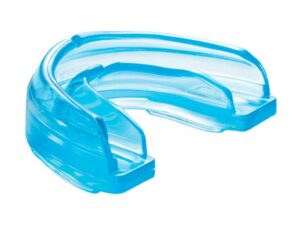Tips for wearing a mouthguard with braces
February 22nd, 2021
Adolescents are active, so it is no surprise that there are plenty of questions about mouthguards when it comes to orthodontic treatment. In general, a mouthguard is a great investment for protecting the teeth, especially in high-contact sports. They should be considered for many sports and activities, even if braces are not being worn. Here are some common questions and answers:
-
Can you wear a mouthguard if you have braces?
Yes, you can wear a mouthguard when you have braces. There are special mouth guards that are made specifically to fit over braces.
-
What sports require a mouthguard with braces?
Many high school sports associations require a mouthguard for football, hockey, field hockey, lacrosse, and wrestling. The ADA also recommends a mouthguard for other contact sports like basketball and martial arts, as well as other limited contact sports such as baseball, softball, and extreme sports.
-
Is it recommended to use a mouthguard while in braces?
Unless specifically required by your sports association, it can be a personal decision based on your comfort level and ability to breath adequately while performing. The benefit of a mouth guard is it will limit damage to teeth and soft tissues around the mouth when worn properly. Not only will it help protect the teeth, but it will protect the lips and cheeks from injury from any orthodontic appliances.
-
What is the best mouthguard for braces?
In our office, we have found that the Shock Doctor Braces Mouthguard has worked well for many patients. It has a strap so that it can be used in sports like football. The strap can also be removed so that it can be used in sports like basketball.
[caption id="attachment_308" align="alignleft" width="300"]
 Shock Doctor ® Braces mouthguard[/caption]
Shock Doctor ® Braces mouthguard[/caption] -
Can you use a boil and bite mouthguard with braces?
No, you should not use a build and bite mouth guard with your braces. It may wrap around the braces and get stuck in place, or cause damage to the braces. Also, keep in mind that the teeth are continuing to move, so you do not want to have a mouthguard specifically molded to your teeth as they are changing.
-
Can I use a custom made mouthguard while in braces?
No, you will not likely be able to use a custom mouthguard since your teeth are still moving. The mouthguard will not fit for the duration of the treatment, and it may get stuck on the braces if it is forced in place.
-
Where can I get a mouthguard for braces?
You can find a mouthguard for braces online or in some sporting goods stores. Some orthodontists may also have them in their office for patients. At Zach Frazier Orthodontics, we have the Shock Doctor Braces Mouthguard available in office for our patients.
-
Can I wear a mouthguard with Invisalign?
If you are in Invisalign treatment, you should still wear a mouthguard for sports if it is recommended by your association or a sport with significant contact or injury risk (football, basketball, hockey). You can remove your Invisalign and use a general one-size-fits-all mouthguard while playing the sport. You will not be able to use a custom fitting or boil and bite mouthguard as your teeth are still moving. If you are in a non-contact or limited-contact sport, you should continue to wear your Invisalign while you are playing the sport.
-
Can I wear a mouthguard with a palatal expander?
Yes, you can wear a mouthguard with a palatal expander. It will need to be trimmed and adjusted around the expander to allow it to fit properly.
I hope this is helpful to provide some insight on mouthguard recommendations for braces. As always, if you need more information, please reach out to our office anytime - we are happy to help : )




